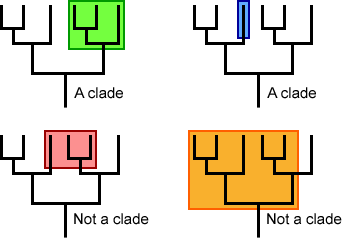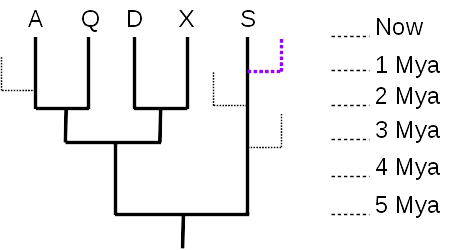A Family Tree That Includes the Common Ancestor, but Not All Its Descendants Is Called Atree
Learning Objectives
- Know and apply the terminology required to describe and interpret a phylogenetic tree.
- Know the unlike types of data incorporated into phylogenetic copse and recognize how this data is used to construct phylogenetic copse
- Translate the relatedness of extant species based on phylogenetic trees
What is a phylogenetic tree?
A phylogenetic tree is a visual representation of the relationship between different organisms, showing the path through evolutionary time from a mutual ancestor to different descendants. Trees tin correspond relationships ranging from the entire history of life on earth, downward to individuals in a population.
The diagram beneath shows a tree of iii taxa (a singular taxon is a taxonomic unit of measurement; could exist a species or a cistron).

Terminology of phylogenetic trees
This is a bifurcating tree. The vertical lines, called branches, stand for a lineage, and nodes are where they diverge, representing a speciation effect from a common ancestor. The trunk at the base of the tree, is actually called the root. The root node represents the most recent common ancestor of all of the taxa represented on the tree. Fourth dimension is also represented, proceeding from the oldest at the bottom to the most recent at the top. What this particular tree tells us is that taxon A and taxon B are more closely related to each other than either taxon is to taxon C. The reason is that taxon A and taxon B share a more recent mutual antecedent than they practice with taxon C. A group of taxa that includes a common antecedent and all of its descendants is called a clade. A clade is also said to be monophyletic. A grouping that excludes 1 or more descendants isparaphyletic; a group that excludes the mutual ancestor is said to be polyphyletic.
The image below shows several monophyletic (top row) vs a polyphyletic (bottom left) or paraphyletic (bottom correct) trees. Find how the clades include the mutual ancestor and all of its descendants (the green and blue examples), while those labeled "not a clade" get out out some mutual ancestors (polyphyletic in red) or some descendants (paraphyletic in orange).

From http://evolution.berkeley.edu/evolibrary/article/side_0_0/evo_06
The video beneath focuses on terminology and explores some misconceptions about reading trees:
Misconceptions and how to correctly read a phylogenetic tree
Trees can exist disruptive to read. A common mistake is to read the tips of the trees and think their order has meaning. In the tree above, the closest relative to taxon C is not taxon B. Both A and B are equally distant from, or related to, taxon C. In fact, switching the labels of taxa A and B would upshot in a topologically equivalent tree. It is the social club of branching forth the time axis that matters. The illustration beneath shows that 1 can rotate branches and not touch the structure of the tree, much like a hanging mobile:

http://evolution.berkeley.edu/evolibrary/commodity/%3C?%20echo%20$baseURL;%20?%3E_0_0/evotrees_primer_08

Hanging bird mobile by Charlie Harper
It can as well be hard to recognize how the copse model evolutionary relationships. One thing to recollect is that any tree represents a minuscule subset of the tree of life.

Given merely the 5-taxon tree (no dotted branches), information technology is tempting to call back that taxon South is the about "archaic" or virtually like the common ancestor represented past the root node, because there are no boosted nodes between Southward and the root. However, there were undoubtedly many branches off that lineage during the form of evolution, most leading to extinct taxa (99% of all species are thought to have gone extinct), and many to living taxa (like the purple dotted line) that are just not shown in the tree. What matters, so, is the total distance along the time axis (vertical axis, in this tree) – taxon S evolved for five million years, the same length of time every bit whatever of the other 4 taxa. As the tree is drawn, with the time axis vertical, the horizontal centrality has no meaning, and serves simply to separate the taxa and their lineages. So none of the currently living taxa are any more than "primitive" nor any more "advanced" than any of the others; they have all evolved for the same length of time from their most recent common ancestor.
The time centrality also allows us to measure evolutionary distances quantitatively. The altitude betwixt A and Q is 4 million years (A evolved for 2 one thousand thousand years since they separate, and Q also evolved independently of A for 2 million years after the split). The distance between A and D is half dozen one thousand thousand years, since they split from their common ancestor iii million years ago.
Phylogenetic trees tin can have different forms – they may exist oriented sideways, inverted (well-nigh recent at bottom), or the branches may be curved, or the tree may be radial (oldest at the centre). Regardless of how the tree is drawn, the branching patterns all convey the same information: evolutionary beginnings and patterns of difference.
This video does a great job of explaining how to interpret species relatedness using trees, including describing some of the mutual wrong ways to read trees:
Constructing phylogenetic trees
Many different types of data tin can be used to construct phylogenetic trees, including morphological data, such as structural features, types of organs, and specific skeletal arrangements; and genetic information, such as mitochondrial Deoxyribonucleic acid sequences, ribosomal RNA genes, and any genes of interest.
These types of data are used to place homology, which ways similarity due to mutual beginnings. This is simply the thought that you inherit traits from your parents, only applied on a species level: all humans have large brains and opposable thumbs because our ancestors did; all mammals produce milk from mammary glands because their ancestors did.
Copse are constructed on the principle of parsimony, which is the idea that the most probable pattern to is the one requiring the fewest changes. For instance, it is much more likely that all mammals produce milk because they all inherited mammary glands from a common antecedent that produced milk from mammary glands, versus multiple groups of organisms each independently evolving mammary glands.
Here is an excellent resources on phylogenetic copse: https://evolution.berkeley.edu/evolibrary/article/0_0_0/evotrees_intro
Source: https://bioprinciples.biosci.gatech.edu/module-1-evolution/phylogenetic-trees/
0 Response to "A Family Tree That Includes the Common Ancestor, but Not All Its Descendants Is Called Atree"
Post a Comment